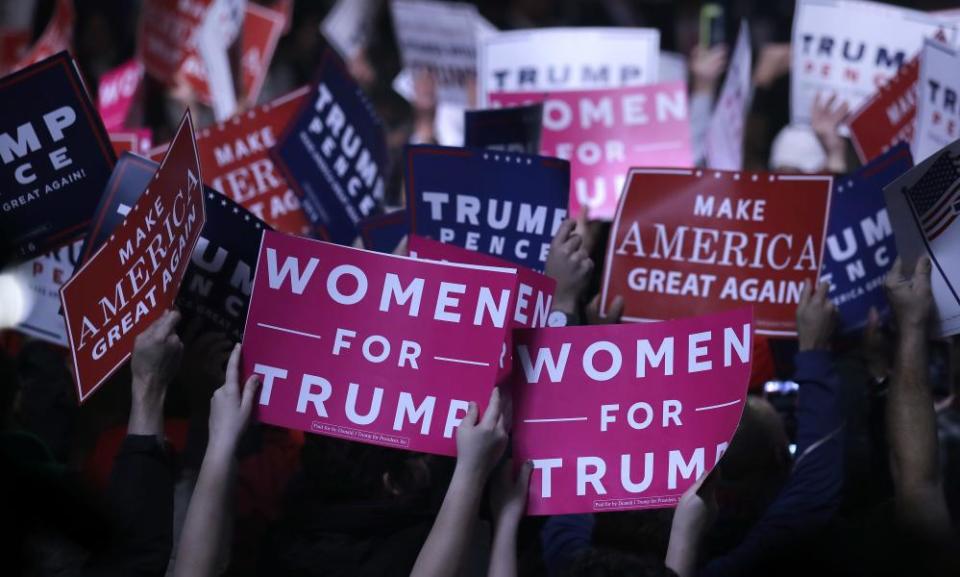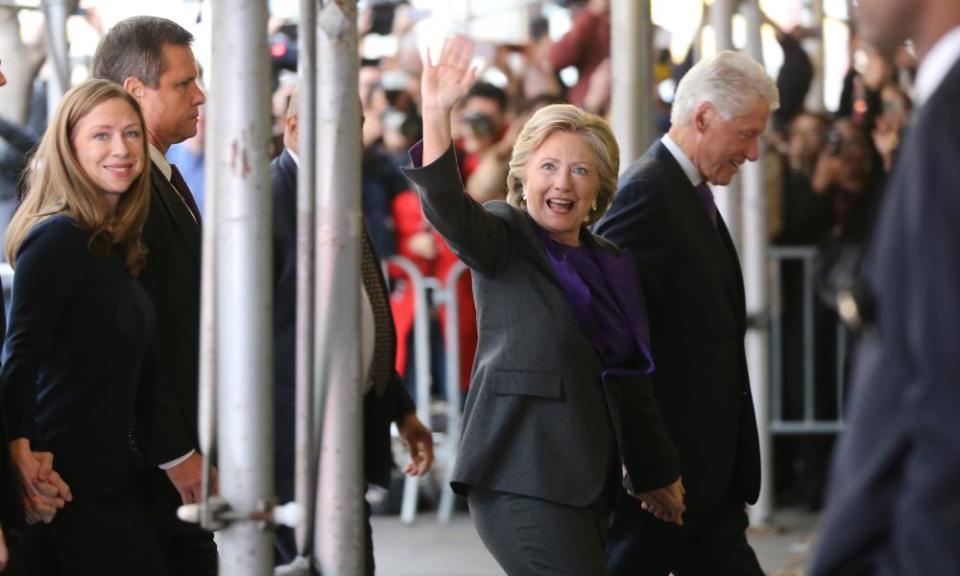Why Hillary Clinton was right about white women – and their husbands
Conventional wisdom says women will show solidarity at the polls. But new research shows that for white women, having a husband trumped the sisterhood

Hillary Clinton hoped to wear white on election night, a tribute to the suffragettes and the sweep of political history. Instead, as she wrote in her new book, the white suit stayed in her garment bag as she donned the gray and purple garment she had intended for her first trip to Washington as president-elect.
Given the opportunity to make history by electing the first female president, women didn’t take it. And ironically, the women who bore the most resemblance to Clinton – white, heterosexual and married – were less likely to vote for her.
Many had expected Clinton to rally women, the same way Barack Obama rallied black voters in 2008 – and if she had, she would have handily trumped Donald Trump. But while Obama won 95% of the black vote, Clinton won just 54% of women – a percentage point less than her male predecessor atop the Democratic ticket. Among white women in particular, she fared even worse: a slim majority voted for Trump.
Last week, Clinton, who has had a lifetime to contemplate the women’s vote, copped to having a theory. “[Women] will be under tremendous pressure – and I’m talking principally about white women. They will be under tremendous pressure from fathers and husbands and boyfriends and male employers not to vote for ‘the girl’,” she said in an interview as part of a tour promoting her new memoir of the 2016 campaign.
People might scoff at the idea that women vote based on what husbands and fathers tell them to do. And tens of millions of dollars in political messaging has been spent based on the assumption that women will vote collectively on equal pay, abortion, and other salient issues regarding women’s autonomy.
But social science backs up Clinton’s anecdotal hunch. “We think she was right in her analysis about women getting pressure from men in their lives, specifically [straight] white women,” said Kelsy Kretschmer, an assistant professor at Oregon State University and a co-author of a recent study examining women’s voting patterns.
“We know white men are more conservative, so when you’re married to a white man you get a lot more pressure to vote consistent with that ideology.”

Individually speaking, such voting behavior is more rational than it may sound.
The key distinction, according to Kretschmer’s research, is that single women tend to cast votes with the fate of all women in mind, while women married to men vote on behalf of their husbands and families (the study was based on a poll of straight women conducted in 2012, before same-sex marriage was legalized nationwide, and draws no conclusions about marriages where neither partner is a man).
That could help explain why, despite the fact that the Democratic party is generally considered to have policies more favorable to women, Republicans have traditionally won the votes of married women.
“Just being married makes women more conservative in their vote choice,” said Kretschmer.
The bottom line is quite literally economic, rather than ideological.
“Women consistently earn less money and hold less power, which fosters women’s economic dependency on men,” Kretschmer and her co-authors write in their study. “Thus, it is within married women’s interests to support policies and politicians who protect their husbands and improve their status.”
In fact, since men are the primary breadwinners in the vast majority of American families, their wives may well see equality-focused measures as setting their husbands – and therefore their family – back.
“Some married women perceive advances for women, such as lawsuits to mitigate pay discrimination, as coming at the expense of their male partners,” the authors continue.
Married straight women siding with the economic interests of their husbands and families over the collective interests of women was something authors observed anecdotally during the campaign, too.
A college-educated woman identifying as a liberal Democrat confided to Kretschmer – not wanting to be identified, as a Trump voter – that she had voted for him over Clinton because her husband’s job depends on the coal industry; she saw Trump as the candidate that would protect it, and by extension her family’s economic interests. Kretschmer called her story “the clearest, most heartbreaking validation of our article that I had ever heard”.
Yet the conventional wisdom going into the election, as one Atlantic story summed it up at the time, was that “the 2016 race has turned the battle of the sexes into an all-out war”: Trump and Clinton had divided not just men and women, according to the narrative, but expressly “men and women who are married to each other”. Or so readers were told.
A few weeks later, it was clear this theory didn’t amount to much: married women preferred Clinton to Trump by a paltry two percentage point margin. And it shouldn’t have come as a surprise.

Studies from at least as far back as 2006 have shown married women have very often voted in the economic interest of a male partner; and given wage disparities and men’s traditional breadwinner status, it makes a good deal of sense from an economic perspective that married women might have voted that way. Though the pay gap has narrowed, a significant disparity endures, and so too do attendant gendered expectations.
And a study published Wednesday by Pew Research Center found Americans continue to see men as the primary financial provider, even as women’s contributions have grown.
While 71% of women polled said it was “very important” for a man to be able to support a family financially, just 41% of women said the same about their own gender. Among white men and women, the number who said it was important for women to be able to support a family was just 27%, compared to 52% among black men and women.
Most striking of all, perhaps: the more educated women were, the less likely they were to say women being able to support a family was important.
The trend lines are disturbing: across race and education, the groups most likely to be able to support a family on their husband’s income alone – white women, and women of all races with a college degree – were the most likely dismiss the importance of women being able to support a family.
They may also offer context for other reports, like one from a New York City-based thinktank in 2015, which found black women were significantly more ambitious than white women in the workplace (22% of black women said they wanted to hold powerful positions, as compared with just 8% of white women).
Kretschmer’s study, published in Political Research Quarterly, further illuminates such dynamics by seeking to distill the extent to which women see their own fates as linked to the fates of other women in the country.
Using data from the 2012 American National Election Study, her team analyzed responses from more than 2,000 women to the following question: “Do you think that what happens generally to women in this country will have something to do with what happens in your life?” Women who said “yes” were then asked to report the extent to which they felt that was true.
The findings showed unmarried women were significantly more likely than married women to answer yes to the question. And the gaps between how single women and married women answered were largest among white women and Latina women.
The origins of such gaps are thought to be economic as well as cultural. White women, according Bureau of Labor Statistics data, are more likely to marry and stay married than women of any other race, for instance. Meanwhile, many Latinas, the report authors note, maintain ties to a culture of “‘familism’ which advocates for the interests of the family as a whole to take precedence over the interest of any single member of the family”.
Single and married black women were the most likely to see their fates as bound up in the fate of all women, and, significantly, were much more likely than white or Latina women to be the primary breadwinners in their families as well as the more educated partner when they married.
“Racial groups have really strong collective identity bonds, so it wasn’t surprising that when they had a black candidate to vote for, they experienced really high turnout,” said Kretschmer. “For women, one of the interesting things is they consistently lack social identity bonds.”
False assumptions that women will vote as a unified bloc go back to the earliest days of the women’s suffrage movement: “Women always take the part of each other,” a New York Herald editorial warned in 1870 of Victoria Woodhull’s bid for president, “and if the women can be allowed to vote Mrs Woodhull may rely on rolling up the heaviest majority ever polled in this or any other nation.”
But no such advantage ever materialized for Woodhull, who saw the suffragist-inspired support that had once boosted her quickly crumble when aspects of her personal life came under attack.
As Amanda Hess pointed out in the New York Times, the women’s vote has always disappointed its proponents – from the 1916 presidential race when suffragists failed to defeat Woodrow Wilson, to the Equal Rights Amendment, which was defeated in the 70s by conservative women arguing middle-class ones would be set back.
Lost on too many in the last election cycle was just how much of an uphill battle Clinton faced, not just for winning over the electorate, but for winning women’s votes at all.

